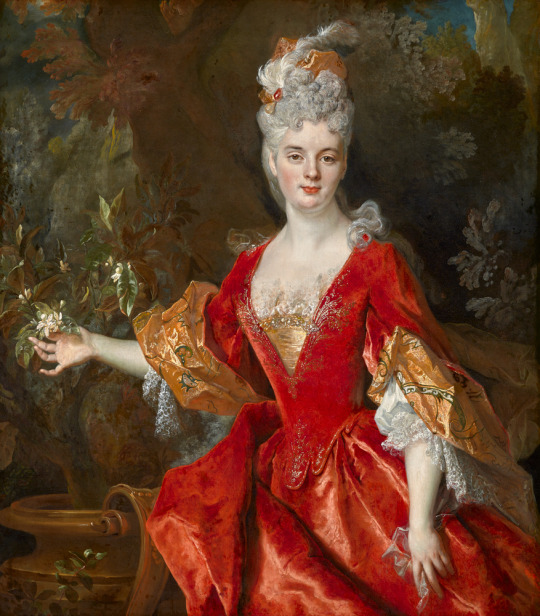#jeanne-elisabeth de beauharnais
Photo

I absolutely love this painting and the dress and more people should be seeing it.
Portrait of a young woman, known as Jeanne-Elisabeth de Beauharnais
Former title: Portrait of a Lady of the Barral Family 1711
by Nicolas de Largillière
She married on January 9, 1711 (date of the painting) in Orléans with Michel Bégon de la Picardière.
#1700s#18th century#art#dress history#history#art history#jeanne-elisabeth de beauharnais#nicolas de largillière
308 notes
·
View notes
Text
(A while ago @apurpledust mentioned wanting to know more about Duroc's children, so here's what information I have)
Duroc and his wife, Maria de las Nieves Martínez de Hervas, had two children, both of whom died tragically young. (Hervas left instructions that her gravestone should be engraved with "To the unhappiest of mothers".)
Their first child, Napoléon Louis Sidoine Joseph Duroc, was born on 24 February 1811 in Paris. Named for the emperor and his two grandfathers (Claude Sidoine de Michel du Roc and José Martínez de Hervas), he lived for just over fourteen months. The infant’s health was never good; Duroc wrote to Bertrand in March 1812 that “[Hervas] is doing well but her son has been and always is ill”. (As Duroc’s biographer Danielle Meyrueix notes, when writing of his wife and child he habitually referred to “her son” rather than “our son”. Perhaps not the most engaged of fathers.) Napoléon died on 6 May 1812 at Maidières in Lorraine. The architect Pierre Fontaine, noting in his journal that Hervas had asked him to design a tomb for her lost son, wrote that the child had been “a few days older than the King of Rome and destined to enjoy at that prince’s side all the favor with which the Emperor honored his father.”
Their daughter Hortense Eugénie Nieves Duroc was born on 14 May 1812, eight days after the young Napoléon’s death. (In a letter, Duroc implied that the news of the boy’s death had been kept from Hervas, who was in Paris, to avoid imperiling her health.) Named for her godmother, Hortense de Beauharnais, she was baptized in January 1813 alongside the duke of Bassano's daughter. After Duroc’s death in May 1813, Napoleon transferred the duchy of Friuli to her, writing to Hervas that Hortense would be “assured of my constant protection”. He also remembered her in his will, leaving her a large sum of money and recommending, in one last attempt at matchmaking, that she marry Bessières’s son, the duke of Istria. Hortense’s aunt wrote in 1823 that “Hortense is perfectly sweet, she’s a rare child for her spirit and intelligence, who her poor father would have been happy to see so fine in all respects”. She died of pneumonia on 24 September 1829 after three days of illness, aged seventeen.

A 1933 biography of Charles-Nicolas Fabvier (Hervas’s second husband) identifies this painting by Jeanne-Elisabeth Chaudet as a young Hortense Duroc. It was sold at an auction a few years ago with the title “Young Embroideress”, so either the sitter’s identity has been lost since then or it may never have been Hortense at all.
Duroc’s long liaison with the dancer Emilie Bigottini may also have resulted in at least one child. Felix Bouvier, writing a biographical sketch of Bigottini in 1909, claimed that “children were born of this irregular union, a daughter and a son named Odilon”. However, Odilon (full name Pierre Dominique Jean Marie Odilon Michel du Roc), born in 1801, was the son of Duroc’s cousin Géraud Pierre Michel du Roc, the marquis de Brion. On Duroc’s death, Napoleon made Odilon a page in the imperial household. (This may have given rise to Bouvier’s claim, as it seems to have confused people at the time. Caulaincourt had been tasked with sorting out Duroc’s affairs, including a substantial amount of money for Bigottini, and Duroc’s sister Jeanne implied that he had gotten the wrong impression from one of Duroc’s requests: “On the subject of the allowance for little Odilon, M. the duke of Vicenza was misled…he took a step which pained me very much”.) As for the daughter, all I’ve been able to find so far is a remark from Laure Junot that “It was known that the count Armand de Fuentès had had a daughter with Mademoiselle Bigottini, and that Duroc was in the same position”.
46 notes
·
View notes